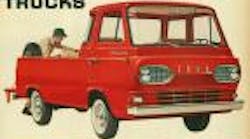In an age when long-venerated automotive names and models are rapidly disappearing from the world stage – Oldsmobile, Pontiac, and Mercury, to name but a few – it’s nice to note one that’s successfully withstood the test of time.
I’m talking about the Ford E-Series van, which first rolled off the assembly line 50 years ago – way back in 1961.
Let’s put that date in a little perspective, shall we? In January that year, John F. Kennedy took office as our 35th president. On April 12, 1961, Soviet cosmonaut Yuri Gagarin became the first human being in space. The luckless failed invasion of Cuba – known as the “Bay of Pigs” disaster – occurred five days later.
Diana Spencer, later to marry Prince Charles and become Princess of Wales, was born on July 1 that year; construction on the grim Berlin Wall began just over a month later, on August 13. On an even darker note, President Kennedy sent 18,000 military advisers to South Vietnam that fall – a moment that officially marks the beginning of the Vietnam War.
On a lighter note, Roger Maris drilled in his 61st homer in October 1961 the break Babe Ruth’s 34-year record home run record; and Maris’ record would stand for 36 years. Finally, Marvel introduced the Fantastic Four to the comic book faithful in 1961 – just one of the many legendary fictional superheroes crafted by Stan Lee.
This, then, is the world into which the Ford E-Series made its debut. It’s interesting to note that the E-Series originally was introduced as a commercial vehicle in three body styles: Pickup, Delivery Van and Station Bus.
The pickup delivered up to 30 mpg and carried a three-quarter-ton payload in a big seven-foot box. The van offered 204 cubic feet of cargo space, with double doors at the side and rear for easy loading. The Station Bus, with twice the interior room of the biggest station wagon of the day, was designed to accommodate up to eight passengers when fitted with two optional bench seats as well as the standard driver and passenger buckets.
Only later did it roll out the “Club Wagon” line, designed for customers looking for a personal-use vehicle with light towing capabilities.
Over the ensuring decades, the E-Series underwent a bevy of design changes – getting bigger and beefier, capable of hauling heavier and bigger loads for commercial operators and consumers alike.
[Here’s one example of how folks retool the lowly van; in this case turning a 1999 model into a snowboarder’s home on wheels. The 241 Research and Development team at Area 241, Donner Summit, CA, did the work on this vehicle. Incidentally, the “Donner Summit” is an area that holds grim meaning for my family, for that’s where my brother suffered life-altering crippling injuries after being caught in an avalanche while extreme skiing.]
By 1969, the second-generation Econoline vans had hit the market, modernized with V8 engines and air conditioning and joined by the Club Wagon series, which offered a revolutionary new twin I-beam front suspension for a smooth, quiet ride. In 1971, power steering became an Econoline option, and then the model line expanded again to include the Parcel Delivery Van and a cutaway model for the rapidly growing RV market.
In 1975, when van popularity hit new heights, Ford introduced the third generation of Econoline. The new van featured body-on-frame construction, higher gross vehicle weight ratings, an improved interior package and a wider selection of engines. This design was offered in the same basic configuration for the next 17 years.
Partly because of the van’s popularity with commercial bodymakers, Ford introduced a chassis cab model in 1978, followed by higher payloads on most models in 1981, the year when halogen headlamps became standard.
The fourth generation of Econoline vans and Club Wagons were completely redone in 1992 – redesigned aerodynamically and stylistically – with the addition of airbags. In 1997, the line was again refreshed with overhead-cam engines, including the addition of a V10 block
For 2001, Ford introduced the E-Traveler model, keeping up with the increasingly crowded market of SUVs and passenger vans, and debuting the shorter, snappier “E” version of the name. “E-Series” replaced “Econoline” in company literature, and Ford kept close tabs on an ever-changing market to make certain its long-standing product would thrive.
Then for 2008, Ford streamlined the E-Series, reintroducing the series as a strictly commercial vehicle and revamping the offerings to meet its emerging fleet customer needs. Cargo space was increased. Chassis and suspension improvements led to a more solid ride and also resulted in best-in-class capability. The front end design was inspired by Ford Super Duty to emphasize that this was a Built Ford Tough van.
[Just for fun, here’s a walkaround video tour produced for the then-new 2008 E-Series model.]
Today, Ford is offering a commemorative 50th anniversary edition to celebrate the half-century mark achieved by the E-Series van – available as an XLT model, the van’s premium package.
The anniversary edition features what Ford calls "unique" blue metallic exterior paint, specially embroidered “Econoline” front seatbacks and unique “Econoline 50 Years” badging on the left-rear cargo door, the OEM said.
True, there probably won’t be a lot of takers for this high-end model in the workaday commercial world, but that’s almost beside the point.
For the noteworthy part here is that this celebratory model (if you can call it that) acknowledges the longevity, not of a fancy sports car or “hoity-toity” luxury sedan, but of an honest-to-goodness working vehicle. A tool, in other words, that takes a daily beating and usually finishes the day dirtier than it began, with dings and scrapes a plenty, yet remains ready to roll back out and get to work all over again.
Nice to see something plain, simple, and hard working like the van finally getting it’s due.







